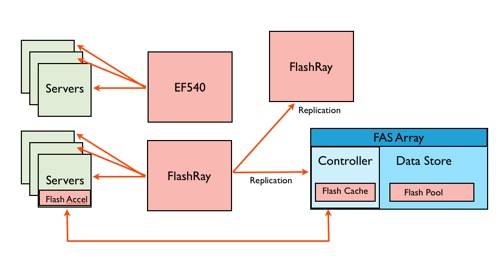This article is more than 1 year old
FlashRay shines out from Sunnyvale
NetApp's journey to Mars
NetApp has unveiled FlashRay, its all-flash array work-in-progress that is the focus of its Mars project. The product should become available some time in 2014 and will enter beta test in the middle of this year.
The Sunnyvale-headquartered company made three announcements today. It is producing the EF540, an all-flash array in the Engenio product set using that disk drive array product's SANtricity operating system. We wrote about this here. Secondly there is an upgrade to the FAS 6200 high-end storage arrays which we mentioned in the story above and will cover in more detail in a separate story.
Thirdly, and the hot member of the announcement trio, there is FlashRay, a purpose-designed all-flash array that will have integration at the replication level with NetApp's ONTAP arrays. This is not a feature of the EF540.
The schematic below provides an idea of the general positioning of NetApp's flash initiatives and shows where each of NetApp's five flash technologies fit in the NetApp universe:-

NetApp FlashRay and EF540 positioning
- Flash Cache is flash cache in the controller and accelerates I/Os to hot data in all parts of the array.
- Flash Pools are flash cache inside a storage volume and accelerate I/Os to hot data inside that volume.
- Flash Accell is third-party PCIe card flash in servers with NetApp software loading it with with hot data from connected drive arrays such as its own ONTAP arrays. It's purpose is to accelerate application execution in the server in which it is fitted.
- The EF540 is a networked all-flash array with no back-end storage array integration and is designed to accelerate applications in all connected servers by speeding up data I/O access rates far beyond the rates delivered by a disk drive array.
- FlashRay is similar but it will have purpose-designed software and not use a basic disk drive array operating system, like the EF540's SANtricity, and is designed for integration with back-end storage arrays, particularly ONTAP arrays.
The configuration details for FlashRay systems are not available but NetApp is telling us that FlashRay will exhibit:-
- A scale-out architecture,
- Cluster architecture with auto-balancing across the nodes,
- Consistent low-latency performance, high IOPS and high throughput,
- High-availability, and snapshots,
- Integrated data protection,
- Global in-line, variable length deduplication and in-line compression, flash endurance optimisation; these are viewed as table stakes by NetApp,
- World-class file and volume management,
- Data management functions, including object granular data management,
- Application integration,
- Replication and backup to ONTAP arrays and other FlashRays,
- Multi-protocol access,
- Quality of Service with service level provisioning.
NetApp promises that its channel will be able to sell FlashRay systems.
FlashRay background
It was in October, 2012, that we understand Brian - Beepy - Pawloski, NetApp's chief technology officer (CTO) was taken out of that role and given the leadership of the Mars Project, the NetApp R & D project to produce an all-flash array.
Why did this happen?
A purpose-designed all-flash array delivers many times more storage IOPS than a disk drive array, and even a flash-cached disk drive array. Several startups and privately-owned businesses like Texas Memory Systems (which became TMS and was bought by IBM in 2012), Solidfire, Pure Storage, Violin Memory and Whiptail have been demonstrating their extraordinary data access speed advantages over disk drive arrays for some time. All of NetApp's main competitors have all-flash array strategies, notably EMC with its XtremIO acquisition. HP also has its ongoing 3PAR flash array development.
NetApp faced being left behind and also having competitors make incursions into its customer base unless it followed suit. There is a market positioning problem to be overcome and that is NetApp's strong insistence until quite recently that the function of flash in storage was to cache copies of data and not to hold the only copy of data, not to function as a storage tier in its own right.
This cache-centric view has now been ditched. Even when NetApp was working on its Mars project, customer-facing sales and marketing people were pushing the message that flash should not be a data storage tier in the NetApp world. NetApp people might say the cache-centric message was true at the time but having an internal flash tier product being developed while they were evangelising flash as a cache and only as a cache means that line of argument won't hold water.
NetApp in marketing terms has made a U-turn. It may well deny it and probably will, merely acknowledging a slight change in direction. I've had a NetApp office of the CTO guy try to convince me that there is only a need for flash as a cache and not a tier and have seen the strenuous efforts NetApp people have made in the past to deny the validity of cache as a storage tier. Huh! If it quacks like a duck, paddles like a duck and flies like a duck then it is a duck. And this is a U-turn.
FlashRay will probably be an enormously popular storage product inside NetApp's customer base and will face searching comparisons with existing and developing flash arrays. Its development vis-a-vis storage memory in servers will be a topic of much interest and its accretion of storage data management functions will be another focal point. This is a major announcement by NetApp and the FlashRay developers will be under enormous pressure to deliver the promised goods. ®
